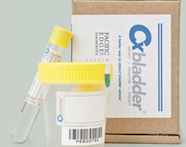Early detection of cancer is key

Cxbladder® is a clinically validated urine test that measures the gene expression levels of five biomarkers in order to diagnose bladder cancer.
Cancer is easier to treat if it is detected early. Unfortunately most cancers are well developed before symptoms are observed. Currently there is screening available for a few high risk genes including BRCA1 and CDH1, or for tumours using techniques such as mammograms, smear tests or urine tests.
New diagnostic tools
We are at the forefront of clinical innovation. By knowing which genes may lead to cancer and by detecting cancer cells while their numbers are small, it will be easier to treat the disease earlier and get a higher cure rate.
Susceptibility and early signs
We're working to identify genes that indicate a susceptibility to cancer and we are increasing our understanding of which genes are best paired with which treatments at the earliest signs of cancer.
- Inherited gastric cancer susceptibility
- Breast cancer: Novel genes involved in susceptibility and response
Detecting single cancer cells
Cancers release cells into their surroundings. For example bladder cancer cells will be present in the urine. CTCR is developing techniques to detect a rare cancer cell from a sea of normal cells.
By detecting these cancers early they can be treated before their burden becomes too great.
A liquid biopsy
For those who currently have cancer or have had it in the past, we are able to track the tumour burden by a simple blood test. DNA from tumour cells shed into the blood can be measured. This information is given to oncologists who can update treatment plans accordingly. This method of assessment can be used in rural and remote areas also.
- Circulating tumour DNA
- Testing for early stage cancer; improving cancer health outcomes from Pacific peoples